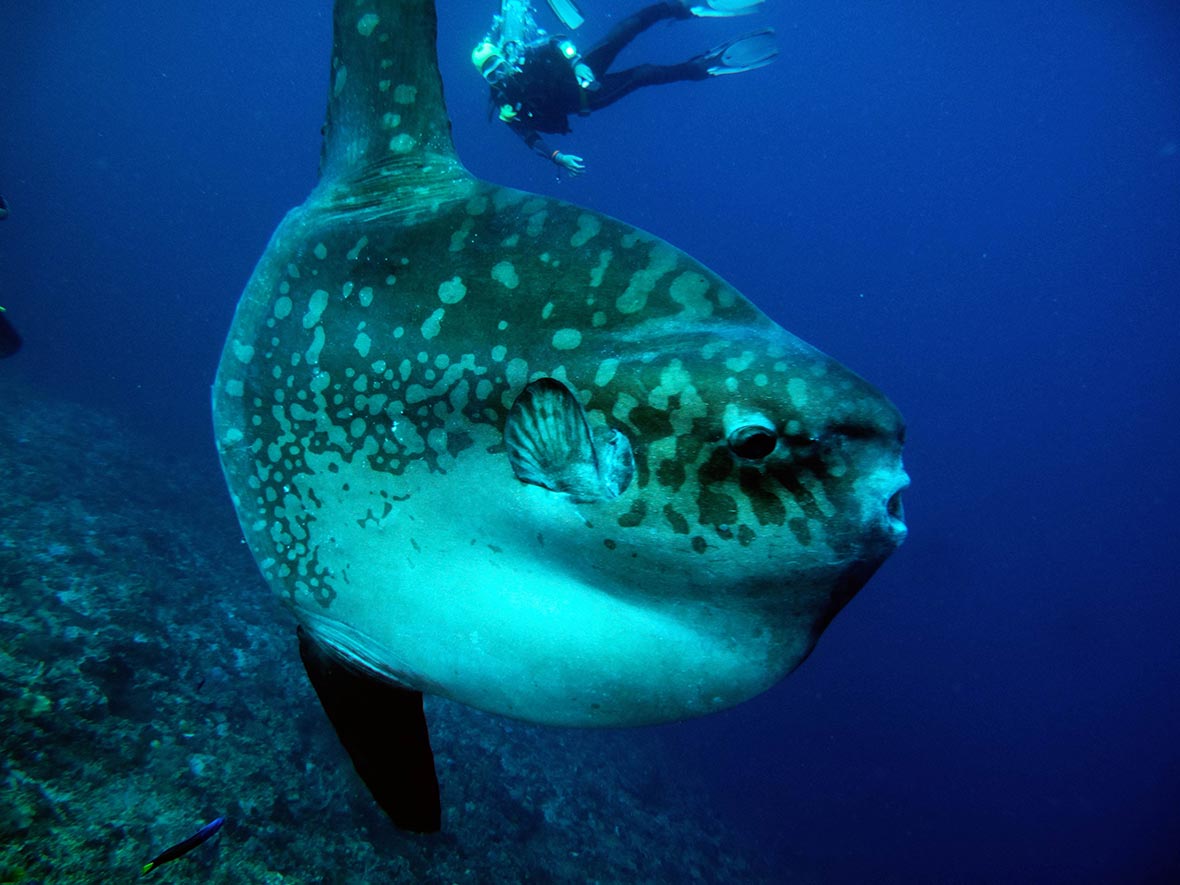About half an hour from Bali are Nusa Ceningan, Nusa Lembongan, and Nusa Penida. On the west side of the largest island, Nusa Penida, is Crystal Bay, a diving site famed for visibility up to 40 meters.
But it’s not just the clear water. Crystal Bay is one of the best sites in Indonesia to spot the mighty Mola Mola, or ocean sunfish. These gentle giants — relatives of the puffer fish — can measure about three meters in diameter and weigh as much a tonne or more — with the largest recorded Mola Mola weighing in at 2.5 tonnes. Seeing one in the wild, especially in the clear waters of Crystal Bay, is a diving experience not to be missed.

Mola Mola go by a few different names throughout the world, based largely on their curious appearance. In Latin Mola means ‘millstone’ — a description of the lump of roughly round, grey rock. In French it’s the moon fish and the Germans call it Schwimmender Kopf, which translates to ‘swimming head’. Their more common name, ocean sunfish, comes from the fact that they bask near the surface to raise their body temperature and allow seabirds to groom them.
Ocean sunfish upper and lower teeth are fused, creating a parrot-like beak, through which they eat jellyfish, squid, eelgrass, and small fish. While Mola Mola have very few natural predators due to their size, they have been recognised as being vulnerable to extinction by the International Union for Conservation of Nature. This status is due to them being caught as bycatch.

ABOVE: Diver with Mola Mola.
Crystal Bay can get crowded during the high season with a number of divers wanting to tick a Mola Mola sighting off their bucket list. Earlier dives generally have better sea conditions and fewer crowds. This is the perfect place for Mola Mola to hang out and visit cleaning stations. The wall that borders the channel beyond the bay has strong currents and cooler water than most other places around Bali.
The currents around Crystal Bay can be unpredictable and extremely strong down currents are likely. Balinese newspapers and Divers Alert Network have issued warnings against inexperienced divers taking on this dive site. Crystal Bay is a dive site for advanced divers only, those who have experience with strong currents. It is recommended that dive groups have a maximum of four divers and that divers stay as close to the reef as possible.

Most dives start out in the bay (which can have some surge) from where divers will head towards Nusa Lembongan and the wall. The bay has large coral bommies surrounded by white sand and plenty of anemones and soft coral, while the wall is excellent for seeing macro fauna. The shallows (between five and 15 meters) could see strong currents but they are usually horizontal which could make for a nice drift dive.
Mola Mola come here for the cleaning stations, where they are serviced by schools of banner fish. Mola Mola are shy but they will often stay in one area for a long time if they are undisturbed. The general suggestion is to keep a minimum distance of 10 meters between yourself and a Mola Mola while it is approaching a cleaning station, and three meters once it is settled and being cleaned.
Other marine life in the area include eagle rays, frogfish, leopard shark, wobbegong shark, and there have been sightings of manta’s and dolphins playing in the currents.

Diving around Crystal Bay is good year-round but Mola Mola season is between July and October. Most divers come to see the Mola Mola in August and September which could lead to crowded dive sites. The chance of seeing Mola Mola can be higher around the full moon when cold water thermoclines are more abundant. As with everything in nature, it is impossible to place an exact date on when the Mola Mola are in the area. Some years they arrive as early as May while other years they stay well into October. The average water temperature is 26º C but it could be as low as 20ºC.
While Crystal Bay is one of the more likely dive sites to see Mola Mola, these interesting-looking fish could be seen around the other 20 or so dive sites around Nusa Penida. Dive sites like Gamat Bay, Ceningan Wall, Manta Bay and Manta Point are all found along the same channel as Crystal Bay, making Mola Mola sightings likely at these sites. They can also be seen along the north coast of Nusa Penida at Toyapakeh, PED, Sental Blue Corner, or Gili Mimpang/Tepekong.
Nusa Penida is one of the only places where Mola Mola sightings are regular and slightly predictable — well, as much as nature can be.




